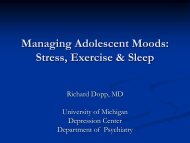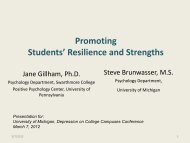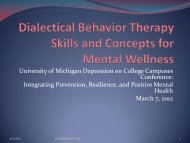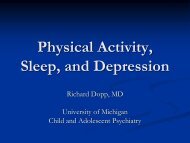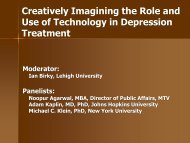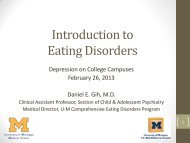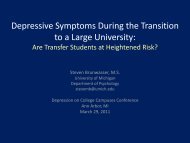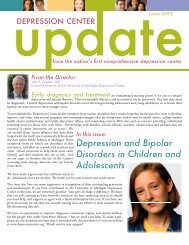Interpersonal Psychotherapy for Depression - University of Michigan ...
Interpersonal Psychotherapy for Depression - University of Michigan ...
Interpersonal Psychotherapy for Depression - University of Michigan ...
Create successful ePaper yourself
Turn your PDF publications into a flip-book with our unique Google optimized e-Paper software.
<strong>Interpersonal</strong> <strong>Psychotherapy</strong> <strong>for</strong><br />
<strong>Depression</strong><br />
Heather A. Flynn, PhD<br />
Associate Pr<strong>of</strong>essor<br />
Director, Adult <strong>Psychotherapy</strong> Services<br />
Department <strong>of</strong> Psychiatry<br />
<strong>University</strong> <strong>of</strong> <strong>Michigan</strong><br />
hflynn@umich.edu
Workshop Expectations<br />
• Literacy in IPT including exposure to<br />
demonstrations and practice<br />
• Decide whether IPT will be useful in<br />
your practice and if you‟d like to gain<br />
additional training<br />
• Learn about next step training<br />
opportunities<br />
• Will not be pr<strong>of</strong>icient in IPT
The Burden <strong>of</strong> <strong>Depression</strong><br />
• Depressive and Bipolar Illnesses together lead the world in<br />
burden and disability (Murray and Lopez, 1996; WHO)<br />
<br />
<br />
<br />
<br />
<br />
Unipolar <strong>Depression</strong> responsible <strong>for</strong> 10.7% <strong>of</strong> ALL<br />
disability worldwide<br />
Unipolar Disorder 1st or 4th, depending upon measure<br />
Bipolar Disorder 6 th<br />
When combined, mood disorders are arguably the<br />
MOST disabling<br />
340 million worldwide, 18 million in USA
Widespread<br />
prevalence<br />
Early symptom<br />
onset<br />
Neurogenesis<br />
and brain<br />
changes<br />
Poor treatment<br />
adherence<br />
Burden <strong>of</strong><br />
<strong>Depression</strong><br />
Under-diagnosis<br />
and treatment<br />
Genetic<br />
vulnerability and<br />
stress-genetic<br />
interactions<br />
Little<br />
recurrence<br />
prevention<br />
Recurrences,<br />
chronicity,<br />
loss <strong>of</strong><br />
function
Life course - untreated<br />
Meets criteria <strong>for</strong> Major Depressive Disorder<br />
Ages:<br />
(Stressors designated by arrows)<br />
Child-Adolescent Adult Older
Severity<br />
Response, Remission, Recovery, Relapse,<br />
Recurrence & Chronicity<br />
adapted from Kupfer & Frank 2001<br />
Remission<br />
Recovery<br />
‘Normalcy’<br />
Response<br />
Relapse<br />
Recurrence<br />
Symptoms<br />
X<br />
Incomplete<br />
recovery<br />
Syndrome<br />
Chronicity<br />
16 wks 12 mo 12 mo<br />
Treatment phases<br />
Acute Continuation Maintenance<br />
RX<br />
Time
<strong>Depression</strong> and<br />
mania are brain<br />
illnesses<br />
Brain imaging: <strong>Depression</strong> vs. Mania<br />
PET scan, depression<br />
PET scan, mania<br />
PET scan, depression<br />
Brain metabolism in depression and<br />
mania, same patient, different days<br />
Baxter, 1983
Percent <strong>of</strong> people diagnosed with depression<br />
Stress interacts with genotype in<br />
onset <strong>of</strong> depression<br />
50<br />
s/s Genotype<br />
l/l Genotype<br />
40<br />
30<br />
20<br />
10<br />
0<br />
0 1 2 3 4<br />
Number <strong>of</strong> Stressful Life Events Experienced
Treatment<br />
• Psychotherapies: e.g. CBT, IPT<br />
• Medications (Antidepressants)<br />
• Somatic Treatments: ECT, rTMS, VNS<br />
• Phototherapy<br />
• Lifestyle: sleep, exercise, diet
Psychotherapies and Antidepressant Medications<br />
Appear to Work in Different Brain Areas<br />
(Goldapple…Mayberg, AJP, 2004)<br />
CBT and IPT<br />
<br />
<br />
Cortical “Top-<br />
Down”<br />
Brody et al,<br />
ArchGenPsy<br />
2001<br />
Antidepressants<br />
<br />
Subcortical<br />
“Bottom-Up”<br />
COMBINED????<br />
<br />
No<br />
neuroimaging<br />
studies<br />
CBT<br />
Paroxetine
Summary <strong>of</strong> <strong>Psychotherapy</strong> Research<br />
• <strong>Psychotherapy</strong> across a range <strong>of</strong> theoretical and<br />
treatment type domains is effective (effect sizes <strong>of</strong> .68<br />
and .85)<br />
• With some exceptions, psychotherapy is a good or better<br />
than psychotropic meds <strong>for</strong> all but most severely<br />
disturbed patients<br />
• Outcomes are substantial across multiple outcome<br />
domains (symptoms, multiple role functioning)<br />
• <strong>Psychotherapy</strong> is relatively efficient and cost effective<br />
• Outcomes <strong>of</strong> psychotherapy are likely to be maintained<br />
over time, even after withdrawal (vs meds)
Evidence-Based <strong>Psychotherapy</strong><br />
• “EBP integrates all scientific evidence and clinical<br />
in<strong>for</strong>mation that is used to guide and improve<br />
psychotherapy processes, interventions, therapeutic<br />
relationships, and outcomes” (Goodheart, Kazdin, Sternberg, p. 3)<br />
• More basically…how we ask and answer the question <strong>of</strong><br />
whether, how, when, why and by whom psychotherapy<br />
improves patient outcomes and public health<br />
• Hundreds <strong>of</strong> psychotherapy research studies have been<br />
published and reviewed
Evidenced-Based Treatment<br />
Treatments that have been supported<br />
using accepted methods <strong>of</strong> science<br />
“An approach to treatment that is lifelong<br />
learning”
So….<br />
<strong>Psychotherapy</strong> is effective, has a strong<br />
evidence base, and works at the<br />
neurobiological and environmental level
Why <strong>Psychotherapy</strong> <strong>for</strong><br />
<strong>Depression</strong>?<br />
• Certain <strong>for</strong>ms <strong>of</strong> psychotherapy (IPT, CBT)<br />
have been empirically demonstrated to be<br />
efficacious <strong>for</strong> the acute treatment <strong>of</strong><br />
depression<br />
• Many individuals will not comply or adhere to<br />
anti-depressant medication therapy<br />
• 67% eventually discontinue meds due to side effects<br />
• non-response in 19-34%<br />
• partial response in 12-15%
Why <strong>Psychotherapy</strong> <strong>for</strong><br />
<strong>Depression</strong>?<br />
• <strong>Depression</strong> is recurrent and is relapse is<br />
likely after medication discontinuation<br />
• <strong>Psychotherapy</strong> has been shown to alter<br />
stressors and an individual‟s responses to<br />
stress (relapse prevention)<br />
• Hopeless patients may get a sense <strong>of</strong><br />
mastery<br />
• Builds new coping skills
Why <strong>Psychotherapy</strong> <strong>for</strong><br />
<strong>Depression</strong>?<br />
• Alternatives to medication are needed:<br />
<br />
<br />
<br />
<br />
<br />
<br />
non-responders<br />
childbearing or nursing<br />
older adults / others taking multiple meds<br />
depressed patients about to undergo surgery<br />
individuals who will not take medication<br />
can be administered by non-prescribing<br />
personnel
Case example – Ms. R<br />
• 28 year old woman, at least 1 prior<br />
episode <strong>of</strong> depression (age 16)<br />
• Gave birth to second child 6 months ago<br />
• Moved; partner recently changed job<br />
• depressed, losing interest in work,<br />
increased conflicts with partner / irritability,<br />
feeling guilty and badly about parenting<br />
• Thoughts <strong>of</strong> something terrible happening<br />
to her baby; wants to “run away”
Basic Tenets <strong>of</strong> IPT<br />
• Treatment selection should consider a wide<br />
range <strong>of</strong> options, not simply the therapists<br />
preference<br />
• Hundreds <strong>of</strong> therapies (450+) have been<br />
described, but only a few have been<br />
empirically tested (IPT, CBT) <strong>for</strong> specific<br />
disorders<br />
• IPT is not a causal explanation <strong>for</strong><br />
depression, but a pragmatic treatment<br />
(empirically based)
IPT Defined<br />
• IPT is a pluralistic approach;<br />
a “focused, time limited psychotherapy that<br />
emphasizes the link between mood and the<br />
current interpersonal relations <strong>of</strong> the depressed<br />
patient while recognizing the roles <strong>of</strong> genetic,<br />
biochemical, developmental, and personality<br />
factors in the causation <strong>of</strong> and vulnerability to<br />
depression”<br />
(Weissman, Markowitz, Klerman, 2000, p.4)
Basic Characteristics <strong>of</strong> IPT<br />
• Helps patients to “change rather than to<br />
simply understand and accept current life<br />
situation” – a focus on what is not working in<br />
a persons life and how to make it work <strong>for</strong><br />
him/her.<br />
• IPT intervenes with symptom <strong>for</strong>mation,<br />
social adjustment and interpersonal<br />
relationships…works predominately on<br />
current problems on a conscious and preconscious<br />
level.
Specific Characteristics <strong>of</strong> IPT<br />
• Time limited – LT therapy may rein<strong>for</strong>ce<br />
avoidance behaviors<br />
• Focused, no open ended<br />
• Current, not past interpersonal relationships –<br />
surrounding depressive episode<br />
• <strong>Interpersonal</strong>, not intrapsychic<br />
• <strong>Interpersonal</strong>, not cognitive behavioral<br />
• Personality is recognized, but not a focus.<br />
Personality may affect 1) outcome <strong>of</strong> tx, 2)<br />
patient-therapist relationship, 3) recurrent<br />
interpersonal problems
Goals <strong>of</strong> IPT<br />
• Remission <strong>of</strong> current depression<br />
• Improved interpersonal capacity<br />
• Tools to cope with future problems<br />
• Insight into needs (<strong>of</strong> self/others) &<br />
choices<br />
• Plan to detect & seek tx <strong>for</strong> future MDE
I. Initial Phase<br />
II.<br />
III.<br />
IPT Overview<br />
Assessment and identification <strong>of</strong> Focus<br />
Area<br />
Middle Phase<br />
Maintain focus on problem area; elicitation<br />
<strong>of</strong> affect and behavior change<br />
Termination Phase<br />
Consolidate Gains; Relapse Prevention
4 <strong>Interpersonal</strong> Problem Areas<br />
1) Complicated Grief<br />
2) <strong>Interpersonal</strong> Role Conflict / Dispute<br />
3) <strong>Interpersonal</strong> Role Transition<br />
4) “<strong>Interpersonal</strong> sensitivity” /<br />
“<strong>Interpersonal</strong> Deficits”
IPT Compared to other<br />
Psychotherapeutic Approaches<br />
Similarities with CBT:<br />
<br />
<br />
<br />
<br />
<br />
<br />
<br />
specifically developed <strong>for</strong> depression<br />
have been empirically tested and found to be<br />
efficacious<br />
Similar techniques that may be “Key Ingredients”<br />
<strong>of</strong> therapy:<br />
gain sense <strong>of</strong> mastery<br />
combat social isolation<br />
restore a sense <strong>of</strong> social belonging<br />
finding meaning
IPT Compared to other<br />
Psychotherapeutic Approaches<br />
• Major Differences involve:<br />
• 1) Focus on interpersonal communications vs internal cognitions<br />
per se<br />
• 2) specific techniques: distorted thinking used only in relation to<br />
interpersonal issues<br />
• Specific difference from psychoanalytic therapies:<br />
• role <strong>of</strong> unconscious may be recognized by the therapist, but not<br />
emphasized<br />
• focus on here and now<br />
• since focus is on changing aspects <strong>of</strong> a persons life that<br />
contributes to depression, the past is not a major focus<br />
<br />
Personality and defense mechanisms are a given and used to<br />
improve communications vs a focus <strong>of</strong> change
IPT and CBT<br />
• CBT – larger evidence base (especially<br />
<strong>for</strong> well defined Axis I disorders)<br />
• CBT training to standard requires more<br />
time and is more difficult<br />
• CBT more widely disseminated
Role <strong>of</strong> the therapist<br />
• Therapist is a patient advocate, not neutral:<br />
UPR, foster positive expectations from therapy<br />
• The therapeutic relationship is not a<br />
manifestation <strong>of</strong> transference: the relationship is<br />
REALISTIC in that the therapist should be seen<br />
as supportive <strong>of</strong> improvement, understanding;<br />
reactions should be discussed in terms <strong>of</strong><br />
relating to other interpersonal relationships<br />
• The therapist is active, not passive: maintain<br />
focus on goals; active role depends on stage <strong>of</strong><br />
therapy<br />
• The relationship is not a friendship
Use <strong>of</strong> the Patient-Therapist relationship<br />
in IPT<br />
• To assess pts attachment style<br />
• Formulate questions about the person‟s<br />
interpersonal relationship and<br />
functioning outside <strong>of</strong> therapy<br />
• In<strong>for</strong>mation about potential <strong>for</strong>ms <strong>of</strong><br />
resistance / potential problems in<br />
therapy<br />
• To plan <strong>for</strong> termination<br />
• To predict the likely outcome <strong>of</strong> therapy
Assessment Phase:<br />
1-2 sessions preceding the therapy<br />
• In addition to diagnostic assessment:<br />
• Note Risk Factors: Family History Mood<br />
Disorder, Early Loss (
Indications <strong>for</strong> Combining Rx<br />
& <strong>Psychotherapy</strong><br />
• Acute & uncontrolled suicidal acts or<br />
plans (consider hospitalization)<br />
• Genetic loading (family history suicide,<br />
bipolarity)<br />
• More severe, recurrent depression<br />
• Co-morbid Borderline, Histrionic,<br />
OCPD<br />
• Need <strong>for</strong> speedy symptom relief
Indications <strong>for</strong> Adjunctive Rx<br />
• Recurrent <strong>Depression</strong><br />
• Marked vegetative signs<br />
• Extreme or uncontrolled mood<br />
• Anhedonia, loss <strong>of</strong> libido<br />
• Significant wt loss<br />
• terminal insomnia<br />
• Post-partum onset
<strong>Psychotherapy</strong> and Medications in<br />
the Acute Phase Treatment <strong>of</strong> Unipolar<br />
<strong>Depression</strong> (AHCPR - meta-analysis)<br />
60%<br />
50%<br />
40%<br />
30%<br />
20%<br />
10%<br />
Dynamic<br />
IPT<br />
CT<br />
BT<br />
Medications<br />
Placebos<br />
0%
<strong>Psychotherapy</strong> RCT‟s have<br />
generally not included:<br />
• Adjustment disorder<br />
• Dysthymia<br />
• Mood and Anxiety NOS<br />
• Symptoms <strong>of</strong> Axis I d/o <strong>of</strong> minimum<br />
duration
Meta-analyses <strong>of</strong> IPT (de Mello et al.,<br />
2005)<br />
• Based on 23 strictly selected RCT‟s<br />
• Overall, IPT was superior to placebo<br />
• Similar to medication therapy<br />
• IPT produced overall fewer drop-outs<br />
than medication treatment (13% vs<br />
23%)<br />
• Slightly superior to CBT (3 studies;<br />
56% remission vs 47%)
The Ingredients <strong>of</strong><br />
Therapeutic Efficacy<br />
• “Common factors contribute a great deal to<br />
positive outcome there<strong>for</strong>e, crucial <strong>for</strong><br />
therapists to intentionally incorporate them.”<br />
• Provide support, establish therapeutic<br />
alliance, in which learning and then<br />
action/application can emerge<br />
• Positive Expectancy<br />
• Warmth & Attention/Caring & genuine<br />
curiosity<br />
• Understanding / Empathy (Bergin & Garfield 1994)
Primary Theoretical Underpinnings <strong>of</strong> IPT<br />
1) Attachment Theory – Bowlby<br />
Biologically based, instinctual drive to <strong>for</strong>m<br />
relationships with others; describes the<br />
ways in which people <strong>for</strong>m, maintain, end<br />
relationships and ways in which they<br />
develop problems with them<br />
Difficulty results from disrupted attachments<br />
with others: specific loss or inadequacy <strong>of</strong><br />
social support network due to a conflict, loss<br />
or transition
2) Communication Theory - Kielser<br />
The ways in which non-functional<br />
communication patterns lead to difficulty in<br />
current relationships<br />
3 dimensions: Affiliation (positive feelings),<br />
Dominance (in charge), Inclusion<br />
(importance)<br />
Problems occur when people unintentionally<br />
elicit negative responses from others<br />
accompanied by lack <strong>of</strong> insight
3) Social Theory – Henderson<br />
Stress in current social relationships<br />
(social support network) is an<br />
independent causative factor <strong>for</strong><br />
psychological distress<br />
Interventions that affect current social<br />
relationships will lead to improved<br />
interpersonal functioning
Functions <strong>of</strong> Attachment- Davies<br />
• Sense <strong>of</strong> security<br />
• Regulation <strong>of</strong> affect<br />
• Promoting expression <strong>of</strong> feeling and<br />
communication<br />
• Base <strong>for</strong> exploration
Attachment and IPT<br />
• Attachment - a person‟s “working<br />
model” / expectations <strong>of</strong> relationships<br />
and individual interactions<br />
• Set‟s the stage (“background music”)<br />
<strong>for</strong> day-to-day as well as global<br />
relationship perceptions and behaviors<br />
• Perturbations in relationship, either real<br />
or perceived contribute to mood and<br />
anxiety
Attachment and IPT<br />
• Relationship functioning becomes selffulfilling<br />
prophesy (interactional behaviors)<br />
• One goal <strong>of</strong> IPT is to help the person bring<br />
about more rein<strong>for</strong>cing / rewarding<br />
interpersonal interactions and experiences<br />
(consistent with Behavior activation)
Patients generally more likely to respond<br />
to short term psychotherapy<br />
• Motivated <strong>for</strong> therapy – expectancy <strong>of</strong><br />
effectiveness<br />
• Capacity <strong>for</strong> insight / ego strength /<br />
psychological mindedness<br />
• Less chronic / severe course <strong>of</strong> illness<br />
• Ability to <strong>for</strong>m a therapeutic relationship<br />
• History <strong>of</strong> response to psychotherapy
Selective Pt Variables <strong>for</strong> IPT <strong>for</strong><br />
<strong>Depression</strong><br />
• Life Events: Recent, focused dispute with significant<br />
other, social or communication problems, recent role<br />
transition or life change, abnormal grief reaction<br />
• Relatively secure attachment style – Low attachment<br />
avoidance (McBride et al., 2006)<br />
• The ability to relate a coherent narrative with the<br />
ability to relate specific dialogue between parties<br />
• A specific interpersonal focus <strong>for</strong> distress<br />
• Modest to moderate need <strong>for</strong> direction and guidance<br />
• Available support network (responsiveness to<br />
environmental manipulation)
Specific patient characteristics<br />
matched to therapy type<br />
• Better social functioning and well being<br />
scores predicted positive treatment<br />
outcome <strong>for</strong> IPT<br />
• Patients reporting fewer depressogenic<br />
cognitions responded more positively to<br />
CBT and meds<br />
• Perfectionism and self-criticism<br />
predicted worse response to<br />
psychotherapy overall.<br />
(Sotsky et al., 1991; Marshall et al., 2008; Blatt et al., 1998)
I. Initial Phase<br />
II.<br />
III.<br />
IPT Overview<br />
Assessment and identification <strong>of</strong> Focus<br />
Area<br />
Middle Phase<br />
Maintain focus on problem area; elicitation<br />
<strong>of</strong> affect and behavior change<br />
Termination Phase<br />
Consolidate Gains; Relapse Prevention
The Initial Phase<br />
4 main tasks:<br />
1) Diagnose the depression<br />
2) Complete the <strong>Interpersonal</strong> Inventory and relate<br />
the depression to the interpersonal context<br />
3) Identify major interpersonal problem areas<br />
4) Explain IPT approach and make a treatment<br />
contract
The Initial Phase<br />
• Key Issues:<br />
Education <strong>of</strong> the patient about depression,<br />
including reassurance and guidance, creates<br />
a sense the problems are being ―worked on‖<br />
right away<br />
Review <strong>of</strong> symptoms – reassures the patient<br />
that they fit a pattern that is anticipated and<br />
understood (by therapist); helps pt<br />
understand that they are part <strong>of</strong> a patterned,<br />
time-limited, treatable illness.
The Initial Phase<br />
• Key Issues:<br />
Patient’s perceptions <strong>of</strong> symptoms should be<br />
elicited without challenge or disagreement<br />
Need <strong>for</strong> medication – severity and recurrent<br />
pattern; the medical model <strong>of</strong> IPT makes it<br />
easily compatible with med tx; present<br />
treatment options and pertinent in<strong>for</strong>mation<br />
about options
Tasks <strong>of</strong> Intermediate IPT<br />
Sessions<br />
• Focus discussion to topics relevant to<br />
problem area - link mood to IP events,<br />
clarify wishes (expectations) and<br />
options, communication analysis,<br />
decision analysis, behavioral activation<br />
• Stay „on focus‟<br />
• Attend to affect and therapeutic<br />
relationship<br />
• Address resistance IF interfering with tx
• What are best <strong>Interpersonal</strong> focus<br />
areas and why<br />
• What are possible interpersonal /<br />
communication patterns that would be<br />
targets <strong>of</strong> intervernion<br />
• Spokesperson – summarize issues and<br />
challenges
Grief<br />
• For IPT, Grief requires the actual death <strong>of</strong> a<br />
loved one; differs from “normal” grief which<br />
typically resolves in 2-4 months and is not<br />
considered to be a psychiatric disorder<br />
• “Abnormal” grief = inadequate grieving can<br />
lead to depression, either following a loss or<br />
sometime later when reminded <strong>of</strong> the loss by<br />
current events (usually another loss)<br />
• Delayed Grief<br />
Distorted Grief
Grief - Complicated Bereavement<br />
• Ambivalence<br />
• Multiple Losses<br />
• Inadequate grief in bereavement period<br />
• Avoidance behavior about the death<br />
• Anniversary reactions<br />
• Fear <strong>of</strong> illness that caused the death<br />
• Hx <strong>of</strong> preserving environment <strong>of</strong> loved one<br />
• Absence <strong>of</strong> supports during bereavement<br />
(Weissman et al 2000)
Grief<br />
• Complicated grief may not always be<br />
obvious and requires careful questioning<br />
about loved ones who have died (e.g.<br />
circumstances <strong>of</strong> death and emotional and<br />
behavioral reactions to it)<br />
• Often, the person feels badly about him /<br />
herself, and idealizes the lost person; Goal<br />
is to clearer, more complex, realistic<br />
perception <strong>of</strong> the relationship. Help person<br />
to avoid fixating on the death itself, but more<br />
on the complexities <strong>of</strong> the relationship.
Grief<br />
• Two goals <strong>for</strong> depression that centers on Grief:<br />
• 1 – facilitate delayed mourning process<br />
• 2 – help reestablish interests and<br />
relationships that may substitute <strong>for</strong> what<br />
has been lost<br />
• Often, when a person is grieving, the therapist<br />
will serve as missing social network used to<br />
explore feelings etc.<br />
Emphasis on “quiet” allowance <strong>of</strong> expression <strong>of</strong><br />
emotion
IPT Strategies - Grief<br />
• Recall sequence <strong>of</strong> events be<strong>for</strong>e,<br />
during and after the death<br />
• Reconstruct the lost one<br />
• Reconstruct the lost relationship<br />
• Explore associated feelings/regrets<br />
• Help pt to bring into focus memories <strong>of</strong><br />
the loast person and emotions related<br />
the experiences with the lost person<br />
(Weissman 2000)
IPT - Grief<br />
• Goals: Facilitate mourning process & help<br />
patient to reestablish interest & relationships<br />
to substitute <strong>for</strong> what has been lost<br />
• Strategies: Review depressive symptoms &<br />
relate onset to death;reconstruct relationship<br />
with deceased; describe sequence &<br />
consequences <strong>of</strong> events prior, during & after<br />
death; explore associated feelings; consider<br />
ways to become involved with others.<br />
(Weissman 2000)
<strong>Interpersonal</strong> Role Disputes<br />
• Defined within IPT as ―a situation in which that<br />
patient and at least one significant other have<br />
non—reciprocal expectations about a<br />
relationship‖; These become the focus <strong>of</strong><br />
therapy if they appear to be important in the<br />
onset and perpetuation <strong>of</strong> the depression<br />
• Identification <strong>of</strong> a role dispute <strong>of</strong>ten involves<br />
careful assessment <strong>of</strong> current important<br />
relationships; listen as much <strong>for</strong> what is omitted<br />
as what is said about relationships: insufficient<br />
or over-idealized descriptions provide clues
<strong>Interpersonal</strong> Role Disputes<br />
• Non-reciprocal expectations about<br />
relationship with significant other(s)<br />
• Communication problems<br />
• Differences that may or may not be<br />
reconcilable<br />
• Focus IF important in onset and<br />
perpetuation <strong>of</strong> the depression<br />
(Weissman 2000)
<strong>Interpersonal</strong> Role Disputes<br />
• General goals in working on role disputes:<br />
• 1 – identify the dispute<br />
• 2 – make choices about a plan <strong>of</strong> action<br />
• 3 – modify non-adaptive communication<br />
patterns and / or re-assess expectations <strong>for</strong> a<br />
satisfactory resolution<br />
• * Therapist has no investment in a particular<br />
outcome – must be driven by the patient<br />
• Helping patients to understand the nature <strong>of</strong> the<br />
dispute (expectations etc) may take the entire<br />
course <strong>of</strong> therapy
Staging the Dispute<br />
• Impasse - discussion stopped/low level<br />
resentment/the “silent treatment”<br />
• Renegotiation - awareness <strong>of</strong> differences &<br />
active ef<strong>for</strong>ts to bring about change/arguing<br />
• Dissolution - irretrievably disrupted/<br />
considering ending the relationship<br />
(Weissman, Markowitz& Klerman)
IPT Goals - Role Disputes<br />
• Outcome:<br />
changed expectations and behavior<br />
<strong>of</strong> pt +/or other;<br />
OR accept that which cannot<br />
change;<br />
OR dissolution<br />
(Weissman 2000)
<strong>Interpersonal</strong> Role Disputes<br />
• Other strategies:<br />
Look <strong>for</strong> parallels in other relationships<br />
Help patient to recognize complex, mixed<br />
feelings about the situation and devise<br />
strategies <strong>for</strong> managing them (e.g.<br />
assertiveness)<br />
Patient should get to the point <strong>of</strong> directly<br />
expressing needs to the other person<br />
Use <strong>of</strong> role playing
Social Role Transitions<br />
• Normative progression through life<br />
cycle<br />
• Biological - adolescence, childbirth, end<br />
<strong>of</strong> childbearing potential, aging, medical<br />
illness<br />
• Social - entering college, leaving home,<br />
marriage, divorce, job promotion or<br />
loss, retirement
<strong>Interpersonal</strong> Role Transitions<br />
• <strong>Depression</strong> <strong>of</strong>ten occurs as a result <strong>of</strong><br />
difficulty dealing with a life change; persons<br />
with depression are more likely to experience<br />
a role change as a loss – again, the goal is to<br />
bring about a more complex, well rounded,<br />
realistic perception <strong>of</strong> the change<br />
Examples: marriage, divorce, job change, moving,<br />
leaving home, new responsibilities, retirement,<br />
changing roles in important relationships,<br />
graduation etc. Most are associated with<br />
progression to another part <strong>of</strong> the life cycle
<strong>Interpersonal</strong> Role Transitions<br />
• Changes are not inherently good or bad, but<br />
have advantages and disadvantages<br />
associated with them<br />
• In depression associated with role<br />
transitions, the person feels hopeless to<br />
cope with the change, but <strong>of</strong>ten knows he /<br />
she “needs to make it
<strong>Interpersonal</strong> Role Transitions<br />
• Difficulty coping with the change is<br />
associated with:<br />
1 – loss <strong>of</strong> familiar social supports<br />
2 – management <strong>of</strong> accompanying<br />
emotions (sadness, fear, anger)<br />
3 – demands <strong>for</strong> new social skills /<br />
attachments<br />
4 – diminished self-esteem
<strong>Interpersonal</strong> Role Transitions<br />
• 4 tasks associated with managing Role Transitions:<br />
1 - Giving up the old role – this resembles facilitation <strong>of</strong> grief<br />
2 - Encouraging expression <strong>of</strong> affect – elicit feelings<br />
3 - Developing new social skills:<br />
Help the patient realistically assess assets and skills needed to<br />
manage the transition, looking <strong>for</strong> over and underestimation <strong>of</strong><br />
skills; helpful to have the person imagine the worst thing that<br />
can happen around the new transition<br />
Difficulty developing new social skills may involve incorrect, or<br />
stereotyped assumptions about the role; i.e. marriage<br />
4 – Establishing Social Supports – carefully review<br />
opportunities available in the new role <strong>for</strong> getting involved<br />
with others
Enhance Social Supports<br />
• Need to <strong>for</strong>m both new & familiar types<br />
<strong>of</strong> relationship with new people<br />
• Review opportunities <strong>for</strong><br />
connection/involvement with others<br />
• Encourage behavioral activation<br />
“Whom do you know? Who can help you?<br />
Are there people you want to get to<br />
know?”<br />
(Weissman 2000)
<strong>Interpersonal</strong> Sensitivity<br />
(Weissman 2000)<br />
• Hx <strong>of</strong> social impoverishment,<br />
inadequate or unsustaining IP relations<br />
• Chronic social isolation & loneliness<br />
• Increased severity <strong>of</strong> distress<br />
• Role out Dysthymic Disorder & Social<br />
Phobia & not related to recent transition<br />
• ? Of cause & effect - does chronic<br />
depression arrest development (McCullough<br />
2000)
<strong>Interpersonal</strong> Deficits (sensitivity)<br />
(Weissman 2000)<br />
• Hx <strong>of</strong> social impoverishment,<br />
inadequate or unsustaining IP relations<br />
• Chronic social isolation & loneliness<br />
• Increased severity <strong>of</strong> distress<br />
• Role out Dysthymic Disorder & Social<br />
Phobia & not related to recent transition<br />
• ? Of cause & effect - does chronic<br />
depression arrest development (McCullough<br />
2000)<br />
focus <strong>of</strong> last resort in IPT
Goals & Strategies - Deficits<br />
(Weissman 2000)<br />
• Reduce social isolation<br />
• Increase social contact: quality and<br />
quantity<br />
• Encourage development <strong>of</strong> new<br />
relationships<br />
• Focus on past relationships including<br />
negative and positive aspects<br />
• Explore repetitive or parallel problems<br />
in these relationships
IPT - Deficits<br />
• “You can talk openly about your difficulties,<br />
hopes & fears here. This shows that you are<br />
capable <strong>of</strong> an intimate friendships. But we‟re<br />
not friends or family. Let‟s focus on the<br />
importance <strong>of</strong> your life outside <strong>of</strong> the therapy.<br />
Who can you talk to among your friends or<br />
family the way you are talking to me? How<br />
can we help you connect or overcome fear <strong>of</strong><br />
being open? Whom do you have to help in<br />
your life? How can you approach them? Who<br />
have you been about to confide in?”<br />
(Weissman 2000)
<strong>Interpersonal</strong> Strategies and<br />
Techniques <strong>for</strong> Facilitating Change<br />
• Use discrepancies between effective &<br />
ineffective IP responses to identify<br />
maladaptive elements<br />
• Communication analysis to guide more<br />
effective communication<br />
• Decision analysis to reveal alternatives and<br />
consider consequences <strong>of</strong> potential choices<br />
• Modify role relationship models<br />
• Role playing (Beitman 1999; Weissman 2000)
Communication Analysis<br />
• Detailed account <strong>of</strong> conversation or<br />
argument with significant other with<br />
feelings and intentions<br />
• Help pts recognize unpleasant feelings<br />
• Assist with direct expression &<br />
strategize ways to cope when<br />
overwhelmed<br />
• Encourage assertion with appropriate<br />
expression <strong>of</strong> anger (Weissman 2000)
Decision Analysis<br />
• ? What has pt already tried<br />
• Help pt recognize broadening range <strong>of</strong><br />
options and insist action held <strong>of</strong>f until each<br />
option explored<br />
• “what would you want to happen in this IP<br />
situation? What solution to this would make<br />
you happiest? What alternatives do you feel<br />
you have now? Why don‟t we try to consider<br />
all the choices you have?”<br />
• Explore consequences, advantages &<br />
disadvantages <strong>of</strong> each line <strong>of</strong> behavior
Termination <strong>of</strong> Treatment in IPT<br />
• Specifically discuss termination at least<br />
2-3 sessions be<strong>for</strong>e ending<br />
• Termination Tasks:<br />
• Giving up a relationship<br />
Establishing sense <strong>of</strong> competence to deal<br />
with future problem autonomously
Termination Phase - IPT<br />
• Feelings <strong>of</strong> sadness are inevitable and<br />
should be expected as important part <strong>of</strong> the<br />
process <strong>of</strong> termination that provides<br />
therapeutic opportunity to work through<br />
• Need to differentiate normal sadness with<br />
endings from clinical major depression<br />
• Loss begets loss: Other ending/separation<br />
might emerge in the material<br />
• Opportunity <strong>for</strong> a „good bye‟<br />
(Weissman 2000; Luborsky 1984)
Tasks <strong>of</strong> Termination<br />
• Explicitly discuss end <strong>of</strong> treatment<br />
• Ask/elicit reactions to end <strong>of</strong> treatment;<br />
patient‟s may not not volunteer or have been<br />
aware <strong>of</strong> associated feelings<br />
• Normalize sadness, apprehension, anger<br />
with endings<br />
• Emphasize patient‟s autonomous<br />
competence; Attend to patient‟s successes<br />
• Acknowledge alternative supports
Self-efficacy<br />
• Patient‟s may attribute gains to therapist<br />
effects and worry that they will not be<br />
maintained after therapy ends<br />
• Important to highlight beginnings <strong>of</strong> new<br />
coping, new behaviors and facilitate their<br />
taking credit in order to enhance their sense<br />
<strong>of</strong> self-efficacy/competence<br />
• In final 4 session, systematically call<br />
attention to patient‟s successes & supports
Final Sessions<br />
• Reflect, review, give & receive<br />
feedback<br />
• Discuss future needs, potential areas <strong>of</strong><br />
future difficulty with contingency plans<br />
• Credit gains, social risks taken to date<br />
& development <strong>of</strong> social skills even in<br />
midst <strong>of</strong> depression<br />
• Wish them well; genuine feedback on<br />
the process
Maintenance Phase IPT<br />
• IPT appears to prevent recurrence after<br />
recovery<br />
• 2 Large Pittsburgh Studies<br />
1) 128 Outpatients with a history <strong>of</strong> 2 or<br />
more past episodes <strong>of</strong> MDD<br />
Acute phase treatment consisted <strong>of</strong> a<br />
combination <strong>of</strong> IPT and high dose<br />
imipramine (>200 mg / day)
Pittsburgh Maintenance Study: Cont:<br />
Responders maintained on high dose med,<br />
while IPT was tapered to monthly sessions<br />
<strong>for</strong> 4 months<br />
Then, randomly assigned to a) ongoing high<br />
dose <strong>of</strong> meds, b) med + monthly IPT, c)<br />
monthly IPT alone, d) monthly IPT +<br />
placebo, e) placebo + clinical management
Pitt maintenance study:<br />
Results:<br />
• Meds alone: 80% recovered after 3 years<br />
• Placebo: less than 20% survived 3 years<br />
• Monthly IPT less efficacious than meds<br />
and did little to enhance its effects<br />
• IPT superior to placebo<br />
• Low does IPT vs high dose meds<br />
• IPT worse <strong>for</strong> patients with reduced delta<br />
sleep; better <strong>for</strong> those high on adherence<br />
to IPT regimen
IPT Maintenance Dose Study<br />
(Frank et al., 2007)<br />
• 233 Women with recurrent MDD who achieved<br />
remission with either IPT alone or IPT + SSRI<br />
• Randomly assigned to weekly, twice / mo, or<br />
monthly IPT maintenance <strong>for</strong> 2 year follow up<br />
• 25% recurrence among those better with IPT acute<br />
phase alone, 36% among those who required SSRI<br />
then drug discontinuation<br />
• No maintenance sub-group differences<br />
• Overall, monthly IPT maintenance is successful<br />
among those who achieve acute phase remission<br />
with IPT alone, but not as effective <strong>for</strong> those who<br />
required the addition <strong>of</strong> acute phase SSRI.
Neuroimaging Studies<br />
Martin et al – 28 MDD randomly assigned to<br />
IPT vs venlafaxine<br />
• SPECT imaging pre and post treatment<br />
• Right posterior cingulate blood flow increased in IPT<br />
group post tx<br />
• Both groups improved in clinical outcomes<br />
Brody et al – PET in 24 MDD tx with IPT or<br />
paroxetine<br />
• Pt with depression had regional brain metabolic<br />
abnormalities at baseline changed in the direction <strong>of</strong><br />
normalization post-tx in both groups
Other IPT adaptations receiving<br />
empirical support<br />
• Dysthymia – John Markowitz<br />
• Adolescent <strong>Depression</strong> – Laura Mufson<br />
• Elderly <strong>Depression</strong><br />
• Eating disorders<br />
• PTSD<br />
• <strong>Interpersonal</strong> and Social Rhythm<br />
Therapy – Bipolar disorder
<strong>Psychotherapy</strong> Process Research<br />
• Formal monitoring <strong>of</strong> patient progress has a significant<br />
impact on client who show a poor response to treatment<br />
• Standardized feedback about patient progress can work<br />
well to Step up or down treatment intensity based on<br />
patient progress (Lambert, 2007)<br />
• Studies show therapists at all levels are not always alert<br />
to signs <strong>of</strong> treatment non-response (Yalom & Liebserman;<br />
Meyer & Schulte, 2002; Lambert et al., 2003)<br />
• Consultation improves per<strong>for</strong>mance at all levels,<br />
especially regarding treatment challenges
So….<br />
• Evidence based psychotherapy is<br />
effective <strong>for</strong> most, and impact on<br />
clinical and functioning outcomes are<br />
enduring<br />
• Therapist experience and competency<br />
in the model link to clinical outcomes<br />
• Therapists are not accurate at<br />
appraising their pr<strong>of</strong>iciency in several<br />
domains <strong>of</strong> psychotherapy
How Do U.S. Clinicians Learn and Adopt<br />
New Treatment Methods?<br />
Pritchard, Wolfe, Waldron & Miller, ATQ, 1997<br />
6%<br />
4%<br />
14%<br />
20%<br />
29%<br />
Experience<br />
Workshops<br />
Books<br />
Classes<br />
Supervision<br />
Research<br />
27%
Conclusions from MI training study Study<br />
• Pr<strong>of</strong>iciency in MI is not substantially increased<br />
by reading the MI book and viewing MI<br />
videotapes<br />
• Pr<strong>of</strong>iciency in MI is modestly increased by a 2-<br />
day clinical MI training workshop<br />
• Pr<strong>of</strong>iciency in MI is substantially increased by a<br />
2-day clinical training followed by either or both:<br />
Personal per<strong>for</strong>mance feedback from actual<br />
practice<br />
Individual telephone coaching sessions
Community Practitioner Training Study<br />
Conclusions - MI<br />
MI skills can be trained and used at a<br />
high level when using<br />
<br />
<br />
<br />
recorded sessions<br />
interview coding<br />
clinical supervision
IPT Training Standards<br />
Level A: Basic Training in IPT<br />
Participation in an IPT Institute certified<br />
training course lasting one day or more.
Level B: Clinical Certification in IPT<br />
PREREQUISITES:<br />
• Completion <strong>of</strong> a two day Basic Training in IPT Course (Level A).<br />
• Familiarity with the IPT manuals.<br />
• Successful completion <strong>of</strong> written IPT knowledge test.<br />
• Pr<strong>of</strong>essional clinical training in mental health treatment.<br />
THERAPY SUPERVISION:<br />
• Supervision by a certified IPT Institute supervisor <strong>for</strong> two complete<br />
IPT cases.<br />
• Supervision must be provided in individual or group <strong>for</strong>mats.<br />
• Supervision must be based on audio or videotaped recordings <strong>of</strong><br />
sessions.<br />
• Supervision must be based on a minimum <strong>of</strong> one hour <strong>of</strong><br />
supervision per two hours <strong>of</strong> therapy<br />
contact.<br />
• IPT treatment must meet Level B certification standards <strong>for</strong><br />
adherence and quality.
Level C: Research Level/Clinical<br />
Expert Certification in IPT<br />
PREREQUISITES:<br />
• Completion <strong>of</strong> Level A and B certification.<br />
• Pr<strong>of</strong>essional clinical training in mental health treatment.<br />
• Completion <strong>of</strong> a pr<strong>of</strong>essional research training program.<br />
THERAPY SUPERVISION:<br />
• Completion <strong>of</strong> three IPT cases with a certified IPT Institute<br />
supervisor.<br />
• Supervision must be provided in individual or group <strong>for</strong>mats.<br />
• Supervision must be based on audio or videotaped recordings <strong>of</strong><br />
sessions.<br />
• Supervision must be based on a minimum <strong>of</strong> one hour <strong>of</strong><br />
supervision per two hours <strong>of</strong> therapy<br />
contact.<br />
• IPT treatment must meet level C certification standards <strong>for</strong><br />
adherence and quality.
Level D: IPT Supervisor/Trainer<br />
Certification<br />
PREREQUISITES:<br />
• Completion <strong>of</strong> Level A, B, and C certification.<br />
• Completion <strong>of</strong> an IPT Institute certified IPT<br />
Supervisors‟ Workshop.<br />
• Completion <strong>of</strong> pr<strong>of</strong>essional clinical training in<br />
mental health treatment.<br />
THERAPY SUPERVISION:<br />
• Completion <strong>of</strong> five IPT cases with a certified<br />
IPT Institute supervisor.<br />
• Supervision must be provided in individual or<br />
group <strong>for</strong>mats.
• Supervision must be based on audio or videotaped recordings <strong>of</strong><br />
sessions.<br />
• Supervision must be based on a minimum <strong>of</strong> one hour <strong>of</strong><br />
supervision per two hours <strong>of</strong> therapy<br />
contact.<br />
• IPT treatment must meet research certification standards <strong>for</strong><br />
adherence and quality.<br />
TEACHING AND SUPERVISION:<br />
• Co-facilitation <strong>of</strong> a Level A training seminar in IPT at an<br />
acceptable level <strong>of</strong> quality and<br />
adherence.<br />
• IPT teaching and training materials must be reviewed in person or<br />
with videotape review.<br />
• Supervision <strong>of</strong> an IPT trainee case at an acceptable level <strong>of</strong><br />
quality and adherence.<br />
• Supervision <strong>of</strong> IPT must be reviewed in person or with audiotape<br />
review and phone or web<br />
conference supervision.
<strong>Michigan</strong> <strong>Depression</strong> Center<br />
• Established local training models in<br />
IPT, CBT and Motivational Interviewing<br />
• Will be initiating training in IPT and<br />
CBT <strong>for</strong> community clinicians statewide<br />
with the opportunity <strong>for</strong> ongoing<br />
supervision
Resources<br />
• www.academy<strong>of</strong>ct.org<br />
• www.interpersonalpsychotherapy.org<br />
• National Working group on Evidence-<br />
Based Health Care –<br />
www.evidencebasedhealthcare.org<br />
• National Association <strong>of</strong> State Mental<br />
Health Program Directors Research<br />
Institute www.nri-inc.org<br />
• http://www.depressioncenter.org/
Indications <strong>for</strong> long-term or<br />
alternative treatments<br />
• Deficits cases: <strong>of</strong>ten have co-morbid P.D.<br />
• Recurrent <strong>Depression</strong>: consider<br />
maintenance treatment to prevent relapse<br />
• Non-responders who are still acutely<br />
depressed<br />
• Manual suggests either:<br />
<br />
<br />
Referral elsewhere<br />
New & different contract with change in focus and<br />
techniques with same therapist
New Developments<br />
• IPT <strong>for</strong> Eating Disorders<br />
• Dr. Sue Luty (Christchurch, New Zealand)<br />
• Dr. Fairburn (Ox<strong>for</strong>d <strong>University</strong>)<br />
• IPT <strong>for</strong> Perinatal <strong>Depression</strong><br />
• Dr. O‟Hara and Dr. Stuart (Univ. <strong>of</strong> Iowa)<br />
• IPT <strong>for</strong> Social Anxiety<br />
• Dr. Josh Lipsitz (Columbia <strong>University</strong>, NY)<br />
• IPT <strong>for</strong> Dysthymia<br />
<br />
Dr. John Markowitz (Cornell <strong>University</strong>, NY)
New Developments<br />
• IPT <strong>for</strong> Adolescence<br />
• Dr. Laura Mufson (Columbia <strong>University</strong>,<br />
NY)<br />
• IPT <strong>for</strong> Groups<br />
• Dr. Denise Wilfley (Yale <strong>University</strong>)<br />
• IPT <strong>for</strong> Bipolar Disorder<br />
• Dr. Ellen Frank (Univ.<strong>of</strong> Pittsburgh)<br />
• IPT <strong>for</strong> PTSD
Adolescent <strong>Depression</strong><br />
Laura Mufson, Ph.D.<br />
Adaptation<br />
• treatment <strong>of</strong> unipolar adolescent depression<br />
• Developmental issues addressed:<br />
• Separation from parents<br />
• Development <strong>of</strong> romantic interpersonal<br />
relationships<br />
• Initial experiences with death<br />
• Peer pressures<br />
• Family is involved as needed<br />
• Treatment manual modified to reflect issues<br />
pertaining to adolescents
Adolescent IPT (cont‟d)<br />
Core components<br />
• explanation <strong>of</strong> medical model <strong>of</strong> illness<br />
• Psychoeducation<br />
• <strong>Interpersonal</strong> Inventory<br />
• Modify communication patterns<br />
• <strong>Interpersonal</strong> problem solving<br />
• Active parental involvement
IPT-A: Indicators <strong>for</strong> treatment<br />
• Grief reactions<br />
• Parent-child conflict<br />
• Peer conflict due to poor social problem<br />
solving skills and social deficits<br />
• Reaction to life transitions<br />
• Identified social precipitant<br />
• Mild and moderate MDD
Thank you !



